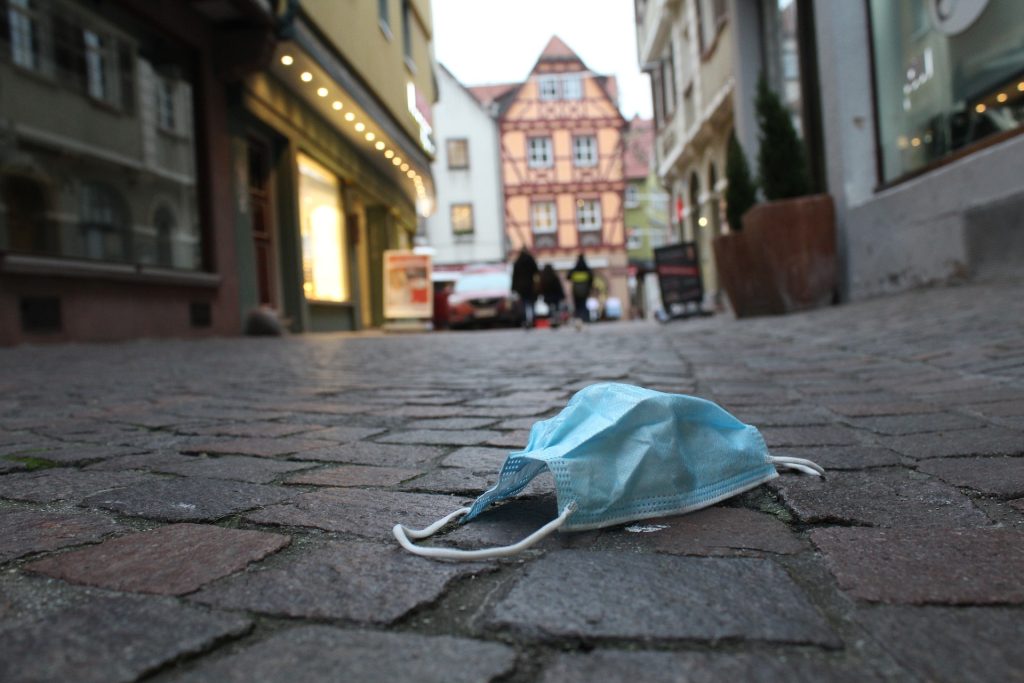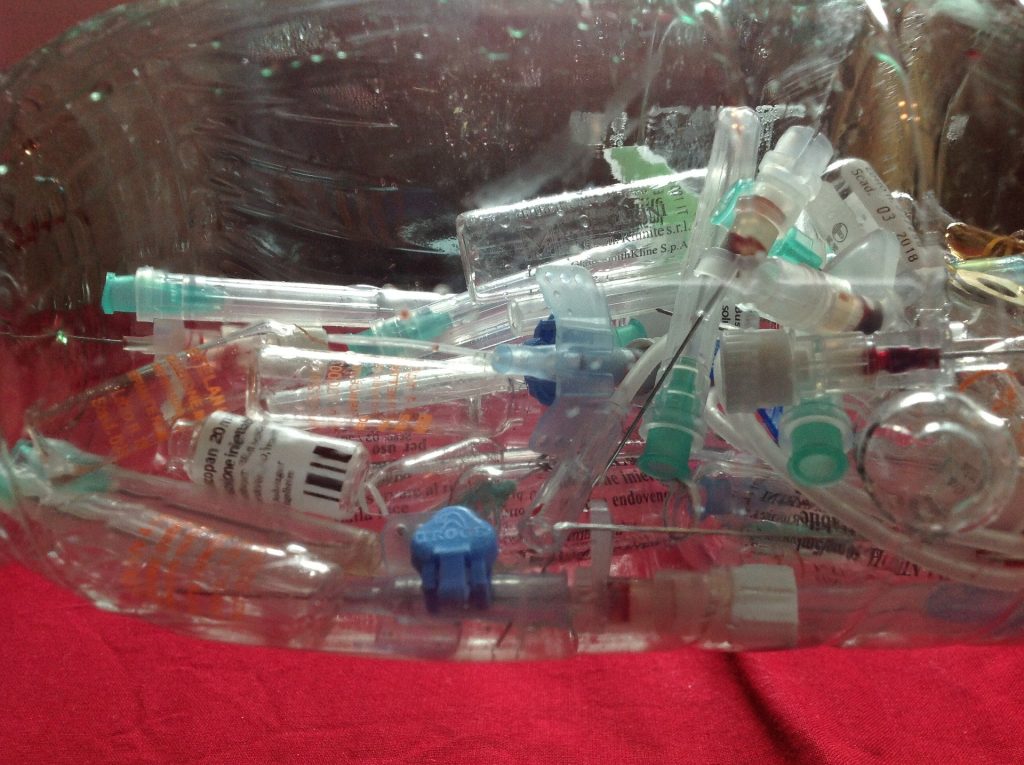Prevention is Better Than Cure: A Medical Waste Approach
Cecilia Akingbade; John Pulido Angel; Mendel Daoundo; Reina Marie Suemith; and Vildan Kaya

Introduction
The improper segregation and disposal of medical waste is an issue that requires special attention as it affects the environment and our health. Medical waste is largely generated in healthcare facilities such as hospitals, clinics, blood banks, research or laboratory facilities, autopsy centers, and nursing homes (World Health Organization [WHO], 2018). The World Health Organization (2018) further classifies it as the following: Infectious, Pathological, Sharps, Chemical, Pharmaceutical, Cytotoxic, Radioactive, and Non-Hazardous or General Waste. With the COVID-19 pandemic, the issues with medical waste have become more visible, especially in terms of weak waste management systems. Hence, sustainable solutions are now being explored to prevent more waste from being generated.
Topic Overview
Some of the hospital wastes are classified as hazardous waste; however, 75% to 90% of medical wastes are risk-free (non-contagious, non-hazardous) and can be mixed with household waste, while the remaining 10%-25% group is dangerous and contains health risks. The quality, amount, and composition of medical waste varies from one country to another and even within a country. The amount of medical waste production in underdeveloped and developing countries is less than in developed countries. Hospitals produce half a million ton of waste each year, which constitutes the 2% of the waste generated worldwide. In developing countries, this rate is higher because dangerous and non-hazardous classification is not made. At the same time, they produce 77% of medical waste. This waste increases as medical practices become dependent on disposable materials. Evaluation of waste generation rate data from around the world shows that hospitals generate approximately 0.5 kg of waste per bed per day (World Health Organization [WHO], (2018).
For information on how to access the transcript for this video, see
Global and Local Perspectives
There are multiple perspectives on a local and global level aiming to reduce the amount of medical waste produced in health care facilities and households.
In the province of Ontario, biomedical waste management is under the Ministry of the Environment and Climate Change (MOECC) Guideline C-4, established as the regulation for the disposal of biomedical waste in Canada in the early 1990s with Browning Ferris Industries. (Pilot, 2016)
Within the scope of the government in Ontario exists The Green Hospital Scorecard (GHS), a benchmarking and recognition program that aims to reflect hospitals’ environmental performance. According to their report, policies need to be updated because some elements that are not included as hazardous (diapers and incontinent products) might also be a source of infectious diseases.
India generates as much as 500 tons of biomedical waste daily, while Saudi Arabia produces more than eighty tons of healthcare waste daily. Thus, the growing number of medical waste poses significant public health and environmental challenges worldwide. Improper disposal methods, insufficient physical resources, and lack of research on medical waste management worsen the situation. The urgent need of the hour is to make healthcare sustainable in the real sense of the word.
Critical Analysis
“In people’s minds now, both single-use protective equipment and single-use medical equipment are understood as safer. But that is not necessarily true,” are the words of Tony Capon, director of the Monash Sustainable Development Institute (Ngo, 2020). It gives a novel insight because most people have not considered how single-use protective and medical equipment pose problems to ourselves and the environment. Moreover, the COVID-19 pandemic has accentuated these gaps in handling medical waste and how mishandling them degrades our environment (e.g., toxic air and water pollutants), making us susceptible to more diseases. In Ngo’s article, she discusses this problem and its relation to human lives, the cost of waste, and climate health (2020). It is important to note that the approaches made by different countries to address this issue are promising. Sterilizing and reusing medical equipment and using a gas-capturing canister to collect excess anesthetics are some sustainable solutions mentioned. With the immense impact of the healthcare industry on the climate crisis, the sustainable solutions they are implementing are challenging existing strategies globally and are helping evaluate if we are genuinely promoting health for all.
Local and Global Solutions
Governments and researchers have to work together and share their newest insights on improvements concerning medical waste disposal. By doing so, we could improve the framework of medical waste disposal all over the world.
Ontario’s Environmental Protection Act in Canada aims to enforce proper biomedical waste segregation and handling. This is primarily directed to generators of biomedical waste and those who are responsible for the treatment, transportation, and disposal of biomedical waste. The WHO also made a guidance document entitled “Safe management of waste from health care activities,” which addresses aspects such as regulatory frameworks, planning issues, waste minimization and recycling handling, storage and transportation, treatment and disposal options, and training.
Innovations on medical waste are being updated, too. For instance, an Israel-based organization, called Envomed, has developed a device named Envomed 80, a machine that sterilizes up to 80 liters of sharps (e.g., needles, syringes, etc.) and infectious waste, and converts it to a non-toxic residue that can be safely disposed of as municipal waste. According to the World Health Organization’s Global Analysis of Health Care Waste in the Context of COVID-19 (2022), compostable face masks are being produced in France and Spain. These are either produced with locally sourced fibers or natural raw materials and have a filtration efficiency of 98% or more (p. 19). The elastic band in France’s mask can be returned to the manufacturer in an airtight plastic bag for their recycling (World Health Organization [WHO], 2022, p. 19). On the other hand, Spain reduces its medical wastes impact by biodegrading their masks via industrial composting for 22 days (p. 19). In Australia, repurposing used face masks as construction materials is being done. Their researchers discovered that combining shredded medical masks that were oven-dried for a day at 105°C with construction materials used for roads, enhanced the performance of the road material (p. 19). Not only does this address PPE disposal, but it also addresses the natural resource demand for construction materials, including quarry aggregates (World Health Organization [WHO], 2022, pp. 19-20).
Reusable medical and respirator masks are currently being developed and piloted. A company in Switzerland is aiming to “produce a medical face mask that filters and deactivates bacteria and viruses—including SARS-CoV-2—and prevents them from spreading by employing a polycationic surface on the mask” (World Health Organization [WHO], 2022, p. 18). This mask can also be used 210 times if used daily and washed weekly; this can save us 210 single-use masks.
Conclusion
The risk of poor medical waste management systems constitutes a great danger to everyone’s health and the environment. However, with solutions ranging from the improvement of the framework for the disposal of medical waste in the world, the use of revolutionary machines like Envomed 80, to creative inventions like compostable face masks, there is hope to scale down the negative impacts of medical waste. May we continue to tackle the root cause of the issue by reevaluating and reinforcing existing well-founded policies and practices and supporting new proposed solutions; this allows us to see how prevention is better than the cure.
References
Andreas. (2022). Medical Waste: Causes, Effects & Solutions. Environmental Conscience. https://environmental-conscience.com/causes-effects-solutions-for-medical-waste/
Envomed. (n.d.). Envomed 80. https://envomed.com/envomed-80/
Ministry of the Environment, Conservation and Parks. (2021, July 16). C-4: The Management Of Biomedical Waste In Ontario. https://www.ontario.ca/page/c-4-management-biomedical-waste-ontario
Ngo, H. (2020, August 13). How do you fix healthcare’s medical waste problem?. BBC. https://www.bbc.com/future/article/20200813-the-hidden-harm-of-medical-plastic-waste-and-pollution
World Health Organization. (2022). Global Analysis of Healthcare Waste in the Context of COVID-19: Status, Impacts and Recommendations. https://www.circularonline.co.uk/wp-content/uploads/2022/02/9789240039612-eng.pdf
World Health Organization. (2018, February 8). Health-care waste. https://www.who.int/news-room/fact-sheets/detail/health-care-waste


